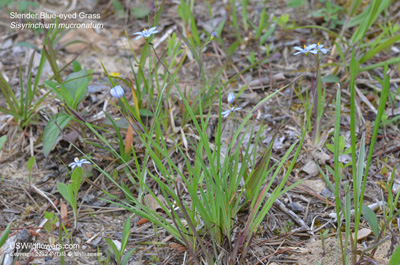Wildflowers of the United States | |||||||||||||
| |||||||||||||
Sisyrinchium mucronatum - Needletip Blue-eyed Grass, Michaux's Blue-eyed-Grass, Slender Blue-eyed Grass, Narrow-Leaved Blue-eyed-Grass. Sisyrinchium is a very confusing genus, even among botanists - much more to a rank hobbyist as myself. Based on the following criteria, I'm calling this S. Mucronatum:
|
There are 41 Blue-eyed Grass species listed in the USDA Plants Database, with every state in the union having at least one species. Sisyrinchium mucronatum is found throughout much of the eastern United States and Canada, but is protected as Endangered or of Special Concern in Maine, Massachusetts, New York, and Ohio. It flowers in late spring and early summer. Found in: AL, CT, DC, DE, GA, IL, LA, MA, MD, ME, MI, MN, MS, NC, ND, NH, NJ, NY, OH, PA, SC, TN, VA, VT, WI, WV   Blue=Native; Grey=Introduced Map from USDA Plants Database: USDA, NRCS. 2017. The PLANTS Database (http://plants.usda.gov, 16 Jan 2025). National Plant Data Team, Greensboro, NC 27401-4901 USA. Search Our Database: Enter any portion of the Scientific, Common Name, or both. Do a general Google search of the entire site: #ad
| #ad
| | ||||||||||
|
Commercial / Cookie Notice Looking for Wildflowers for a specific state? Check here: | |||||||||||||
|
| |||||||||||||


